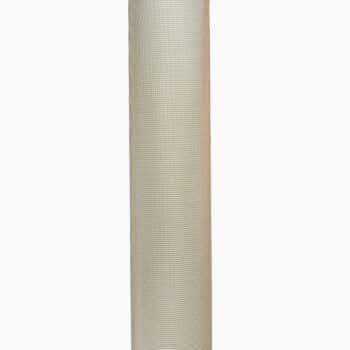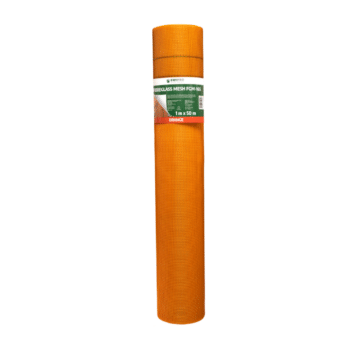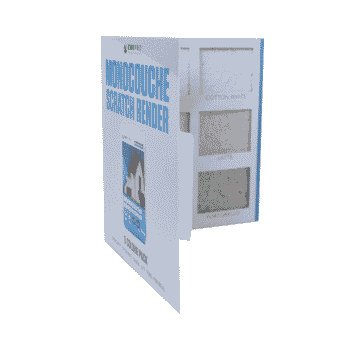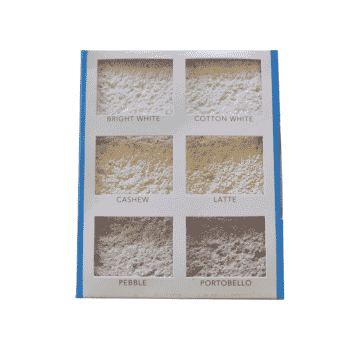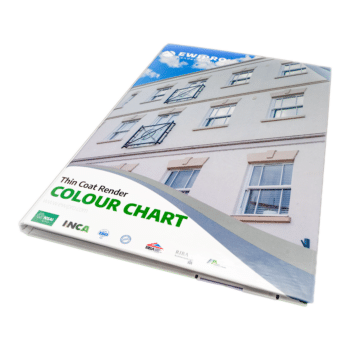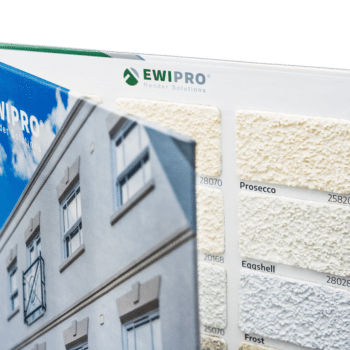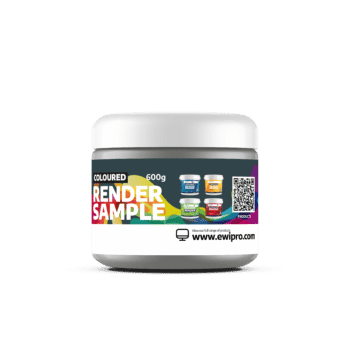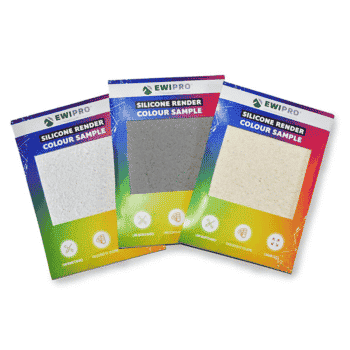Why Use Mesh in External Wall Insulation Systems?
External wall insulation systems have become a popular solution in building conservation and refurbishment projects. EWI systems offer improved energy efficiency, reduced heating costs, and revitalised facades. One key component of these systems is mesh, which enhances durability, strength, and longevity. This article explores the importance of mesh in EWI systems. It will also explore how it contributes to a sustainable and robust building envelope.
What is fibreglass mesh?
Mesh, typically made of alkali-resistant glass fibre, is a vital component embedded in the base coat of the insulation system. This specially designed material features a woven structure that allows it to provide added strength and stability to the EWI system while maintaining its inherent flexibility. The alkali-resistant glass fibre ensures the mesh can withstand the alkaline environment of cementitious renders, preventing degradation over time.
The mesh serves multiple purposes within the insulation system. Firstly, as reinforcement, it strengthens the basecoat by distributing stresses evenly across the surface. This reduces the risk of cracks forming due to thermal expansion and contraction, structural movement, or impact. This reinforcement also increases the system’s durability, ensuring a long-lasting and robust building envelope.
https://youtube.com/shorts/aSkIFLKkxN4?feature=share
Secondly, the mesh enhances the impact resistance of the EWI system, protecting it from damage caused by weather, natural elements, or human intervention, such as accidental impacts or vandalism. Its flexible yet robust structure absorbs and distributes the force of impact, preventing damage to the insulation and maintaining the system’s integrity.
Moreover, the mesh’s inherent flexibility allows it to accommodate minor substrate movements, preventing the EWI system from cracking or debonding. This adaptability is crucial in safeguarding the insulation system from the stress and strain that buildings typically undergo. These stresses are due to temperature fluctuations, structural settling, and other environmental factors.
In addition to these benefits, mesh improves adhesion between the insulation boards and the render. Its woven structure creates a strong bond with both the insulation boards and the render, ensuring a secure, long-lasting connection that minimises the risk of delamination or debonding. This, in turn, contributes to the overall energy efficiency and durability of the EWI system.
-
Fibreglass Mesh (165g/m²) – 50m²
£55.80 Incl. VAT£46.50 Excl. VAT -
Orange Fibreglass Mesh – 50m²
Rated 5.00 out of 5£57.48 Incl. VAT£47.90 Excl. VAT
What are the benefits of including mesh in EWI systems?
Incorporating mesh into an EWI system provides several benefits, such as enhanced durability, improved energy efficiency, breathability, aesthetic appeal, and environmental sustainability. By reinforcing the basecoat and evenly distributing stresses, the mesh creates a robust facade that requires less maintenance and repair. Mesh also ensures a secure bond between insulation boards and render, contributing to an even thermal envelope that prevents heat loss. This, in turn, improves the building’s energy efficiency.
Breathability is another critical aspect of EWI systems, especially for older buildings or new constructions emulating heritage features. Mesh allows moisture to escape from the interior, preventing dampness issues and promoting a healthier living environment. Additionally, mesh provides a stable base for the render, resulting in a smooth, crack-free finish. With various render finishes and colours available, EWI systems can be tailored to match the existing facade or create a unique design. EWI Store offers colour tinting to any RAL, NCS, or custom colour. We also offer our Silicone Renders in various render sizes. Therefore, the opportunity to customise is endless. Thankfully, we can supply various render samples that display the customisable nature of our renders. Mesh contributes to the sustainability of EWI systems by reducing the need for frequent maintenance and repairs. As a result, the building’s carbon footprint is far lower.
-
Monocouche Render Colour Sample
£5.99 Incl. VAT£4.99 Excl. VAT -
EWI Pro Render Sample Chart
£11.99 Incl. VAT£9.99 Excl. VAT -
Coloured Render Sample Pot – 600g
From £7.19 Incl. VATFrom £5.99 Excl. VAT -
Render Colour Sample Sleeve
From £4.20 Incl. VATFrom £3.50 Excl. VAT
Choosing the right mesh for your EWI system is crucial for achieving optimal performance, durability, and sustainability. Factors to consider when selecting mesh include alkali resistance, mesh weight, the building’s exposure to natural elements, human intervention, and potential structural movement. Alkali-resistant glass fibre is ideal for withstanding the alkaline environment of cementitious renders and preventing degradation.
What if you don’t have mesh in your system?
If you don’t incorporate mesh in your EWI system, several issues may arise, affecting the performance, durability, and overall integrity of the system. Some potential problems include:
Cracking: Without mesh to reinforce the base coat and distribute stresses evenly, the EWI system is more susceptible to cracking. This can result from thermal expansion and contraction, structural movement, or impact. Cracks can compromise the insulation’s effectiveness and allow moisture ingress, leading to potential water damage and reduced energy efficiency.
Reduced Impact Resistance: In the absence of mesh, the EWI system’s impact resistance is significantly diminished. This makes the system more prone to damage caused by weather, natural elements, or human intervention, such as accidental impacts or vandalism.
Debonding: Mesh enhances the adhesion between the insulation boards and the render. Without it, the bond may be weaker, leading to potential debonding or delamination of the render from the insulation boards. This not only compromises the system’s performance but also increases the risk of damage and the need for repairs.
Less Flexibility: Mesh adds flexibility to the EWI system, allowing it to accommodate minor substrate movements without cracking or debonding. Without mesh, the system may be more rigid and less capable of handling these movements, increasing the likelihood of failure.
Poor Aesthetic Appeal: A mesh-reinforced base coat provides a stable, crack-free surface for the render. If the mesh is not used, the render may develop cracks or other surface imperfections over time, reducing the aesthetic appeal of the building.
Increased Maintenance and Repair Costs: EWI systems without mesh are more prone to damage and failure, resulting in more frequent maintenance and repairs. This can lead to higher long-term costs and disrupt the occupants of the building.
Compromised Breathability: Mesh can help maintain the breathability of EWI systems, ensuring that moisture can escape from the building’s interior. In the absence of mesh, this function might be compromised, leading to dampness issues and a less healthy living environment.
So what’s the verdict?
Ultimately, fibreglass mesh is crucial to any external wall insulation system. However, we also recommend it for render-only systems as it promotes durability and prevents cracking. Your facade will be suspect to that in any system therefore fibreglass mesh is highly recommended. EWI Store’s Orange Fibreglass Mesh does come with an added benefit in that there is a strip that indicates the overlay required. The mesh has two tram lines on it, painted in black, which simplifies installation. Our partners at EWI Pro have a library of technical drawings including how to overlap fibreglass mesh.
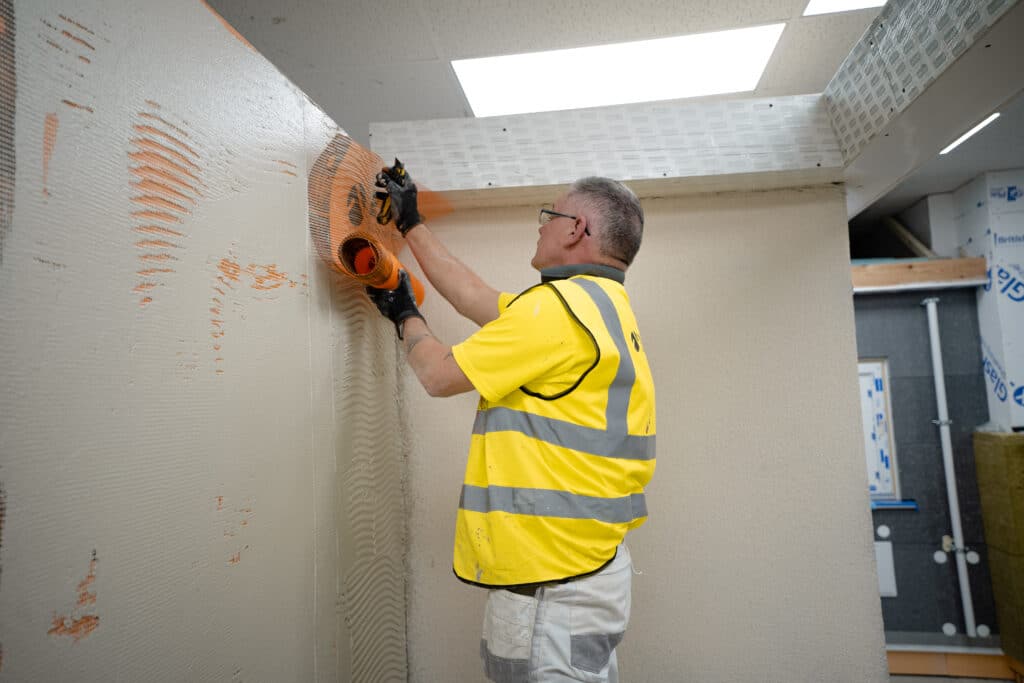
If you have any other questions about our mesh, leave us a comment!
Facebook
Twitter
LinkedIn
Your cart
Trade Account Login

We use cookies on our website to give you the most relevant experience by remembering your preferences and repeat visits. By clicking “Accept All”, you consent to the use of ALL the cookies. However, you may visit "Cookie Settings" to provide personalised consent.
Manage consent
Privacy Overview
This website uses cookies to improve your experience while you navigate through the website. Out of these, the cookies that are categorized as necessary are stored on your browser as they are essential for the working of basic functionalities of the website. We also use third-party cookies that help us analyze and understand how you use this website. These cookies will be stored in your browser only with your consent. You also have the option to opt-out of these cookies. But opting out of some of these cookies may affect your browsing experience.
Necessary cookies are absolutely essential for the website to function properly. These cookies ensure basic functionalities and security features of the website, anonymously.
| Cookie | Duration | Description |
|---|---|---|
| __stripe_mid | 1 year | This cookie is set by Stripe payment gateway. This cookie is used to enable payment on the website without storing any patment information on a server. |
| __stripe_sid | 30 minutes | This cookie is set by Stripe payment gateway. This cookie is used to enable payment on the website without storing any patment information on a server. |
| _GRECAPTCHA | 5 months 27 days | This cookie is set by the Google recaptcha service to identify bots to protect the website against malicious spam attacks. |
| apbct_cookies_test | session | CleanTalk sets this cookie to prevent spam on comments and forms and act as a complete anti-spam solution and firewall for the site. |
| apbct_page_hits | session | CleanTalk sets this cookie to prevent spam on comments and forms and act as a complete anti-spam solution and firewall for the site. |
| apbct_prev_referer | session | Functional cookie placed by CleanTalk Spam Protect to store referring IDs and prevent unauthorized spam from being sent from the website. |
| apbct_site_landing_ts | session | CleanTalk sets this cookie to prevent spam on comments and forms and act as a complete anti-spam solution and firewall for the site. |
| apbct_site_referer | 3 days | This cookie is placed by CleanTalk Spam Protect to prevent spam and to store the referrer page address which led the user to the website. |
| apbct_timestamp | session | CleanTalk sets this cookie to prevent spam on comments and forms and act as a complete anti-spam solution and firewall for the site. |
| apbct_urls | 3 days | This cookie is placed by CleanTalk Spam Protect to prevent spam and to store the addresses (urls) visited on the website. |
| AWSALBCORS | 7 days | This cookie is managed by Amazon Web Services and is used for load balancing. |
| cookielawinfo-checkbox-advertisement | 1 year | Set by the GDPR Cookie Consent plugin, this cookie is used to record the user consent for the cookies in the "Advertisement" category . |
| cookielawinfo-checkbox-analytics | 11 months | This cookie is set by GDPR Cookie Consent plugin. The cookie is used to store the user consent for the cookies in the category "Analytics". |
| cookielawinfo-checkbox-functional | 11 months | The cookie is set by GDPR cookie consent to record the user consent for the cookies in the category "Functional". |
| cookielawinfo-checkbox-necessary | 11 months | This cookie is set by GDPR Cookie Consent plugin. The cookies is used to store the user consent for the cookies in the category "Necessary". |
| cookielawinfo-checkbox-others | 11 months | This cookie is set by GDPR Cookie Consent plugin. The cookie is used to store the user consent for the cookies in the category "Other. |
| cookielawinfo-checkbox-performance | 11 months | This cookie is set by GDPR Cookie Consent plugin. The cookie is used to store the user consent for the cookies in the category "Performance". |
| ct_checkjs | session | CleanTalk–Used to prevent spam on our comments and forms and acts as a complete anti-spam solution and firewall for this site. |
| ct_fkp_timestamp | session | CleanTalk sets this cookie to prevent spam on the site's comments/forms, and to act as a complete anti-spam solution and firewall for the site. |
| ct_pointer_data | session | CleanTalk sets this cookie to prevent spam on the site's comments/forms, and to act as a complete anti-spam solution and firewall for the site. |
| ct_ps_timestamp | session | CleanTalk sets this cookie to prevent spam on the site's comments/forms, and to act as a complete anti-spam solution and firewall for the site. |
| ct_sfw_pass_key | 1 month | CleanTalk sets this cookie to prevent spam on comments and forms and act as a complete anti-spam solution and firewall for the site. |
| ct_timezone | session | CleanTalk–Used to prevent spam on our comments and forms and acts as a complete anti-spam solution and firewall for this site. |
| elementor | never | This cookie is used by the website's WordPress theme. It allows the website owner to implement or change the website's content in real-time. |
| viewed_cookie_policy | 11 months | The cookie is set by the GDPR Cookie Consent plugin and is used to store whether or not user has consented to the use of cookies. It does not store any personal data. |
Functional cookies help to perform certain functionalities like sharing the content of the website on social media platforms, collect feedbacks, and other third-party features.
| Cookie | Duration | Description |
|---|---|---|
| __zlcmid | 1 year | This cookie is used by Zendesk live chat and is used to store the live chat ID. |
| bcookie | 2 years | LinkedIn sets this cookie from LinkedIn share buttons and ad tags to recognize browser ID. |
| bscookie | 2 years | LinkedIn sets this cookie to store performed actions on the website. |
| lang | session | LinkedIn sets this cookie to remember a user's language setting. |
| lidc | 1 day | LinkedIn sets the lidc cookie to facilitate data center selection. |
| UserMatchHistory | 1 month | LinkedIn sets this cookie for LinkedIn Ads ID syncing. |
Performance cookies are used to understand and analyze the key performance indexes of the website which helps in delivering a better user experience for the visitors.
| Cookie | Duration | Description |
|---|---|---|
| __utma | 2 years | This cookie is set by Google Analytics and is used to distinguish users and sessions. The cookie is created when the JavaScript library executes and there are no existing __utma cookies. The cookie is updated every time data is sent to Google Analytics. |
| __utmb | 30 minutes | Google Analytics sets this cookie, to determine new sessions/visits. __utmb cookie is created when the JavaScript library executes and there are no existing __utma cookies. It is updated every time data is sent to Google Analytics. |
| __utmc | session | The cookie is set by Google Analytics and is deleted when the user closes the browser. It is used to enable interoperability with urchin.js, which is an older version of Google Analytics and is used in conjunction with the __utmb cookie to determine new sessions/visits. |
| __utmt | 10 minutes | Google Analytics sets this cookie to inhibit request rate. |
| __utmv | 2 years | The __utmv cookie is set on the user's device, to enable Google Analytics to classify the visitor. |
| __utmz | 6 months | Google Analytics sets this cookie to store the traffic source or campaign by which the visitor reached the site. |
| sib_cuid | 6 months | Purechat uses this cookie to send data to purechat.com, to connect visitors to the reservation team and track visitors to stay on portal. |
| SRM_B | 1 year 24 days | Used by Microsoft Advertising as a unique ID for visitors. |
Analytical cookies are used to understand how visitors interact with the website. These cookies help provide information on metrics the number of visitors, bounce rate, traffic source, etc.
| Cookie | Duration | Description |
|---|---|---|
| _ga | 2 years | The _ga cookie, installed by Google Analytics, calculates visitor, session and campaign data and also keeps track of site usage for the site's analytics report. The cookie stores information anonymously and assigns a randomly generated number to recognize unique visitors. |
| _gat_gtag_UA_61069204_2 | 1 minute | Set by Google to distinguish users. |
| _gat_UA-61069204-2 | 1 minute | A variation of the _gat cookie set by Google Analytics and Google Tag Manager to allow website owners to track visitor behaviour and measure site performance. The pattern element in the name contains the unique identity number of the account or website it relates to. |
| _gcl_au | 3 months | Provided by Google Tag Manager to experiment advertisement efficiency of websites using their services. |
| _gid | 1 day | Installed by Google Analytics, _gid cookie stores information on how visitors use a website, while also creating an analytics report of the website's performance. Some of the data that are collected include the number of visitors, their source, and the pages they visit anonymously. |
| _uetsid | 1 day | This cookies are used to collect analytical information about how visitors use the website. This information is used to compile report and improve site. |
| CONSENT | 2 years | YouTube sets this cookie via embedded youtube-videos and registers anonymous statistical data. |
Advertisement cookies are used to provide visitors with relevant ads and marketing campaigns. These cookies track visitors across websites and collect information to provide customized ads.
| Cookie | Duration | Description |
|---|---|---|
| _fbp | 3 months | This cookie is set by Facebook to display advertisements when either on Facebook or on a digital platform powered by Facebook advertising, after visiting the website. |
| ANONCHK | 10 minutes | The ANONCHK cookie, set by Bing, is used to store a user's session ID and also verify the clicks from ads on the Bing search engine. The cookie helps in reporting and personalization as well. |
| fr | 3 months | Facebook sets this cookie to show relevant advertisements to users by tracking user behaviour across the web, on sites that have Facebook pixel or Facebook social plugin. |
| MUID | 1 year 24 days | Bing sets this cookie to recognize unique web browsers visiting Microsoft sites. This cookie is used for advertising, site analytics, and other operations. |
| NID | 6 months | NID cookie, set by Google, is used for advertising purposes; to limit the number of times the user sees an ad, to mute unwanted ads, and to measure the effectiveness of ads. |
| test_cookie | 15 minutes | The test_cookie is set by doubleclick.net and is used to determine if the user's browser supports cookies. |
| uuid | 6 months | MediaMath sets this cookie to avoid the same ads from being shown repeatedly and for relevant advertising. |
| VISITOR_INFO1_LIVE | 5 months 27 days | A cookie set by YouTube to measure bandwidth that determines whether the user gets the new or old player interface. |
| YSC | session | YSC cookie is set by Youtube and is used to track the views of embedded videos on Youtube pages. |
| yt-remote-connected-devices | never | YouTube sets this cookie to store the video preferences of the user using embedded YouTube video. |
| yt-remote-device-id | never | YouTube sets this cookie to store the video preferences of the user using embedded YouTube video. |
| yt.innertube::nextId | never | This cookie, set by YouTube, registers a unique ID to store data on what videos from YouTube the user has seen. |
| yt.innertube::requests | never | This cookie, set by YouTube, registers a unique ID to store data on what videos from YouTube the user has seen. |
Other uncategorized cookies are those that are being analyzed and have not been classified into a category as yet.
| Cookie | Duration | Description |
|---|---|---|
| _clck | 1 year | No description |
| _clsk | 1 day | No description |
| _uetvid | 1 year 24 days | No description available. |
| AnalyticsSyncHistory | 1 month | No description |
| apbct_pixel_url | session | No description |
| apbct_visible_fields_0 | session | No description |
| apbct_visible_fields_1 | session | No description |
| apbct_visible_fields_10 | session | No description |
| apbct_visible_fields_2 | session | No description |
| apbct_visible_fields_3 | session | No description |
| apbct_visible_fields_4 | session | No description |
| apbct_visible_fields_5 | session | No description |
| apbct_visible_fields_6 | session | No description |
| apbct_visible_fields_7 | session | No description |
| apbct_visible_fields_8 | session | No description |
| apbct_visible_fields_9 | session | No description |
| ct_checked_emails | session | No description |
| ct_has_scrolled | session | No description |
| ct_mouse_moved | session | No description |
| ct_screen_info | session | No description |
| ictf_master | never | No description available. |
| li_gc | 2 years | No description |
| m | 2 years | No description available. |
| SM | session | No description available. |
| testinfinitycookie | session | No description |
| woocommerce_show_tax | 7 days | No description available. |
| wp_woocommerce_session_c5ac76b408021294cb56bcc27eddf8a1 | 2 days | No description |


